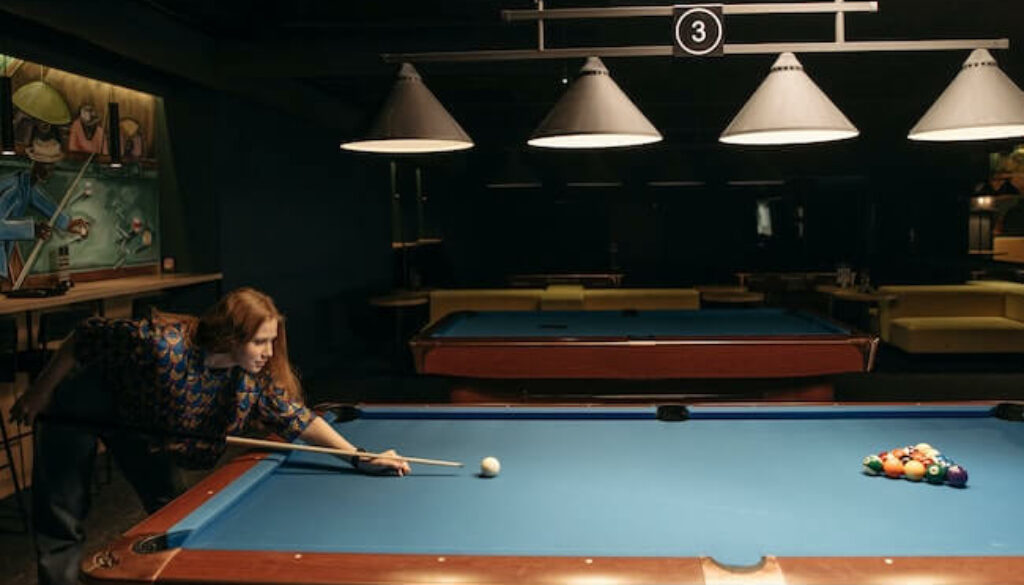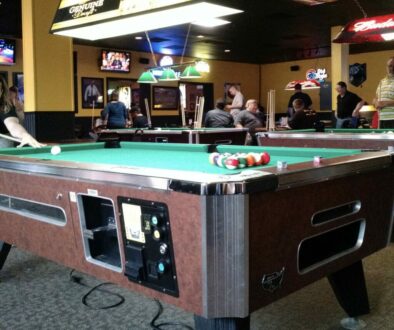The Break Cue – Everything You Need to Know
Table of Contents
Any regular pool player knows the break is arguably the most important shot in pool, outside of making the 8-ball of course. Pocketing balls at the very beginning of the game can be a significant advantage over your opponent, especially if you’re confident in your ability to pocket balls on a crowded table.
In this article, I’ll discuss what a break cue is, how it’s built, how it differs from a jump/break cue, the costs associated, different brands of break cues, and finally, I’ll help you decide whether or not you need a break cue.
What is a Break Cue?
A break cue is an alternative pool cue to a playing cue, and offers a high-performance option for one of the most fun shots in pool – the break.
Break cue construction makes it a perfect tool for pounding the cue ball extremely hard, extremely often. Because of this, using a break cue is a great way to help preserve the condition and performance of your regular playing cue. We will get into more detail about construction below.
Do you need a break cue?
No, you do not need a break cue to play pool. There are many great players out there that break with a regular pool cue. While it’s not required, it certainly has benefits for those who are wanting a little more out of the game.
If you are an experienced pool player without a break cue and are noticing inconsistencies with your breaks such as occasional inaccuracy, the feeling of low power or too much spin, then a break cue might be for you.
If you’re new to pool, it may be best to use a cheaper (or free) house cue to perfect your breaking stroke, then consider upgrading to a separate break cue later.
What is a Jump Break Cue?
A jump break cue is similar to a break cue, but it is a dual-purpose cue. A quite versatile option, the jump break cue can be used for breaking, but also can be used on jump shots. When a player wants to hop the cue ball over another ball to get to the object ball, this type of cue comes in handy.
A jump break cue typically has an additional joint so you can remove the bottom half of the butt in order to get more leverage when shooting almost straight down on the cue ball.
Jump Cue vs. Break Cue
A shaft on a cue that’s made for both jumping and breaking usually has a lighter shaft than a jump-only shaft. A simple break cue that is not used for jumping differs in that it is built more balanced between the butt and the shaft.
Break Cue vs. Playing Cue – What’s the Difference?
A break cue typically plays heavier, much firmer in the shaft, and has a much harder phenolic tip which helps transfer more energy and less spin. All of this is because the break cue is made for, you guessed it, breaking. This cue can be made of wood or carbon fiber, just like a regular playing cue.
While it’s a better idea to use a break cue for break shots, you can still break with a regular playing cue. But, be aware that over time, lots of hard break shots with a regular cue significantly speeds up the wear and tear and can lead to a damaged or flat cue tip. So, we recommend that players who play a lot use a break cue instead.
A playing cue has many more variables in its construction. It will usually be less firm than a break cue and have a softer leather tip which allows for more spin and contact time with the cue ball.
A regular pool cue will likely have more of an impact on your game than a break cue since people play differently, and require different customizations to fit their style of play.
With a break cue, you don’t need to worry about things like maximizing spin or lowering the deflection of a shaft, since break cues are already designed to play with minimal spin and slightly higher deflection due to the firmness of the cue.
Break Cue and Playing Cue Comparison
| Break Cue | Playing Cue | |
| Weight | Usually 18-22 oz | Usually 17-21 oz |
| Shaft Firmness | More firm | Less firm |
| Tip | Harder | Softer |
| Spin | Very little spin | Much more spin |
| Material | Wood or carbon fiber | Wood or carbon fiber |
Break Cue Construction & Characteristics
Shaft
The shaft of a break cue is thicker and quite stiff to create more energy at the end of the shaft in order to transfer it to the cue ball. Any quality break cue shaft is made from hard rock maple wood or carbon fiber.
Maple absorbs shock very well and keeps energy from travelling too far down the back end of the cue, maximizing impact force. Maple is also fairly inexpensive, so this makes for a combination that pool cue manufacturers and pool players love.
Carbon fiber has the most technology and is very strong and eliminates any cue ball squirt, making for a break shot that stays on line. Shafts with carbon fiber tend to be much more expensive.
Tips
Break cue tips are much harder due to the phenolic construction while the shorter, stronger ferrules act as shock absorbers. Some break cues come with a combo tip/ferrule that’s all phenolic.
The heavy duty tip construction helps create a cue that can withstand lots of forceful shots, all while creating ball speed that’s superior to the speed of a regular cue that has a much softer leather tip that creates more spin.
One common question that gets asked a lot is this: Do you chalk a break cue?
Yes, you should chalk your break cue and get any grip you can on that cue ball. A phenolic break cue tip won’t hold nearly as much chalk, but that’s okay because the purpose of a break in pool is not to use a lot of english or hit a shot with a lot of touch.
Check out out recent article on pool chalk for more info!
Butt
The butt end of a break cue is made just as most regular cues are, with hard rock maple wood. This part of the cue is not as important as the tip and shaft.
You want a butt that feels natural in the palm of your hand (cue laughter) and allows you to grip the cue with enough control for those powerful shots.
You can get a butt with a wrap or without a wrap. Most would recommend a wrapped butt on a break cue as it is grippier and is easier to control.
Weight
The ideal break cue weight 18 to 22 ounces, but the max weight depends on which rules you’re playing. In BCA rules, your break cue should never exceed 25 ounces. Under APA rules, there is no weight limit for break cues.
Some break cues also come with a weight bolt that allows you to adjust cue weight. The main thing you need to know is that getting as much force as you can is achieved with both mass (cue weight) and acceleration.
You may be asking yourself: How heavy should a break cue be?
If you feel like you can get more stroke speed and acceleration with less cue weight, then a 18-19 ounce cue might be for you. If you feel like you have a naturally strong stroke, you might want a heavier cue since more mass creates more force.
How Much Do Break Cues Cost?
Break cues will cost anywhere from around $100 (like this Players Cues Sneaky Pete) to $1000 (like this Mezz Power Break G Cue) and that’s not including cues from custom builders.
Break cues can get pretty expensive if you’re a person that likes to try a lot of different things and test out premium brands, which is very fun, but try not to get too caught up in price.
If you buy a cue with a hard tip and firm shaft at a price point that you are happy with, chances are you will be extremely pleased.
For most players, we recommend not buying a super expensive break cue – it’s simply not needed. There are several budget friendly break cues you can buy. They will achieve the same result as expensive break cues.
Break Cue Pros and Cons
Pros
- More consistency
- Less pool cue maintenance, much easier to clean
- More force and cue ball speed due to tip hardness and shaft firmness
- Heavy duty construction
Cons
- More up-front cost when buying an additional cue
- Sometimes has a larger diameter shaft, which bothers some players
- Carbon fiber shafts can get pretty dirty and attract grime
The Most Popular Break Cues by Brand
This is not an exhaustive list of reputable break cues.
Here are some of the more highly-regarded break cues available:
Becue
- Naked Break Cue ($669)
- 29-inch shaft length
- 12.5-mm shaft diameter
- Gradual rise Pro taper
- First ever break cue made entirely of carbon fiber
- Dark Matter Break Cue ($593.10)
- 29-inch shaft length
- 12.5-mm shaft diameter
- Gradual rise Pro taper
Cuetec
- Meteor Break Cue ($189)
- 29-inch shaft length
- 13-mm shaft diameter
- Gradual rise Pro taper
- Joint: ⅜” 14-thread
- Maple construction with fiberglass layer
- 19 oz.
- WCT Break Cue ($295)
- 29-inch shaft length
- 13-mm shaft diameter
- Gradual rise Pro taper
- Joint: ⅜” 14-thread
- Maple construction with fiberglass layer
- Adjustable Acueweight system
- Cynergy Breach Break Cue ($719)
- 29-inch shaft length
- 12.75-mm shaft diameter
- Taom 2.0 break/jump tip
- Gradual rise Pro taper
- Joint: ⅜” 14-thread
- Carbon fiber composite construction
- Adjustable Acueweight system
Jacoby
- Heavy Hitter Break Cue ($328.50)
- 7 different color options
- 29-inch shaft length
- 13-mm shaft diameter
- Gradual rise Pro taper
- Hard maple construction
- Radial joint
- 22 to 25 oz with adjustable weight system
- Feather Weight Break Cue ($328.50)
- 7 different color options
- 29-inch shaft length
- 13-mm shaft diameter
- Gradual rise Pro taper
- Hard maple construction
- Radial joint
- 15 to 18 oz with adjustable weight system
- Black Out Break/Jump Cue ($735)
- Carbon fiber construction
- 10 different color options
- 29-inch shaft length
- 13-mm shaft diameter
- Radial joint
- 17 to 20 oz
- 3-piece cue
Joss
- Thor Hammer Break Cue ($297)
- 29-inch shaft length
- 13-mm shaft diameter
- Hard maple construction
- Gradual rise Pro taper
- Joint: 5/16” 14-thread
Pechauer
- Pechauer Break Cue ($315)
- 29-inch shaft length
- 13-mm shaft diameter
- Pechauer Speed Joint
- Gradual rise Pro taper
- Tiger high-density leather tip
- Maple wood construction
- Pechauer Naked Break Cue ($418.50)
- 29-inch shaft length
- 13-mm shaft diameter
- Pechauer Speed Joint
- Super straight taper
- Pechauer Black Ice shaft
McDermott
- Stinger Break Cue ($315 – $445)
- 29-inch shaft length
- 13.2-mm shaft diameter
- Joint: ⅜” 10-thread
- European shaft taper
- Hard maple construction
- Sledgehammer Break Cue ($346.50)
- Textured sport wrap grip
- 29-inch shaft length
- 13.2-mm shaft diameter
- European shaft taper
- Hard maple construction
If you’re loyal to McDermott, feel free to check out this comparison of the Stinger and Sledgehammer cues.
Meucci
- Meucci Black Break Cue ($318.75)
- 29-inch shaft length
- 13-mm shaft diameter
- Gradual rise Pro taper
- Joint: 5/16” 18-thread
- 19 to 21 oz.
- Hard maple construction
Mezz
- Power Break G Break Cue ($860 – $920)
- 29-inch shaft length
- 13-mm shaft diameter
- Carbon fiber construction
- IGG Powerplate ferrule
- Joint: 5/16” 14-thread
- 2 grip options
- Power Break Kai Break Cue ($500)
- Numerous color options
- 29-inch shaft length
- 13-mm shaft diameter
- Carbon fiber construction
- Joint: 5/16” 14-thread
- 2 grip options
Predator
- BK Rush Break Cue (from $729)
- REVO carbon fiber composite shaft
- 4-piece fused construction butt
- Predator’s most powerful break cue
- BK-hybrid tip
- 29-inch shaft length
- 12.9mm tip diameter
Rage
- Heavy Hitter Break Cue ($106-$122)
- 25 oz.
- 100% maple construction
- Joint: 5/16” 18-thread
- 29-inch shaft length
- 14-mm shaft diameter
- Gradual rise Pro taper
Viking
- Crush Break Cue ($274.50)
- 29-inch shaft length
- 13-mm shaft diameter
- European shaft taper
- Hard maple construction
Are Break Cues Worth It?
Break cues are worth buying, mostly due to the phenolic tip feature and robust construction. But don’t overspend. The vast majority of break cues will accomplish the same exact result. There’s a break cue for every budget, as you can see above.
Figure out what you want in a break cue and buy something that feels good, and that you enjoy looking at.
Wrap Up
We hope you now have all the information you need about break cues. Break cues aren’t required to play this game we all love, but can definitely provide more benefits and more enjoyment for some players.
Hit em hard, and as always, Happy Shooting!




